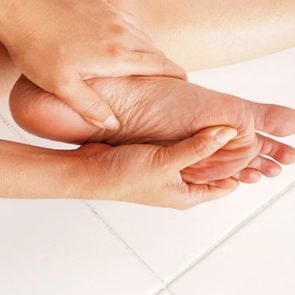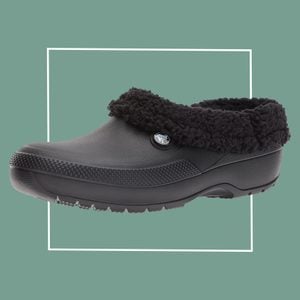8 Best Shoes for Plantar Fasciitis
Updated: Jun. 28, 2021
Don't let foot pain sideline you: These shoes for plantar fasciitis range from sneakers to sandals—and they all meet our experts' standards.
Our editors and experts handpick every product we feature. We may earn a commission from your purchases.
What is plantar fasciitis?
If you often feel an aching in the bottom of your foot, right around where your heel meets the bones that make up your toes, you may be dealing with a condition known as plantar fasciitis. It’s one of the more common orthopedic complaints that foot doctors hear from their patients, mainly because it impacts the majority of everyday activities.
Plantar fasciitis is an inflammation of the plantar fascia, a thick band of tissue that runs along the bottom of the foot and connects the heel bone to the base of the toes. This thick band allows you to walk and supports the arch of your foot.
(Check out the best walking shoes for your feet.)
What causes plantar fasciitis?
“Normal, everyday activities have a strain on these ligaments, but when that area becomes inflamed from overuse, it can cause the ligaments to start to break down, which causes swelling and irritation, which in turn is what causes the pain,” says William Spielfogel, DPM, chief of podiatry in the Department of Orthopedic Surgery and director of the podiatric medicine and surgery residency program at Lenox Hill Hospital-Northwell Health in New York City.
Plantar fasciitis may also be caused by injury. “It’s also possible to tear the plantar fascia as the result of repetitive strain from excessive running, walking, or trauma such as landing from jumping,” Dr. Spielfogel says.
Signs of plantar fasciitis
This condition makes itself known through bottom-of-the-foot pain. The pain and soreness are often more noticeable in the morning, as you get out of bed, or when you stand up after sitting for a long period of time. “The pain and stiffness upon getting up come from the tightening of the plantar fascia that occurs during rest,” says Dr. Spielfogel. “Stretching or massaging the area before standing up can often reduce the pain.”
(These are the ways podiatrists say you’re killing your feet.)
Who is most prone to plantar fasciitis?
Most likely to get plantar fasciitis are people with increased strain and tension on the plantar fascia, including those with overpronation (aka flat feet), a tight Achilles tendon, and restricted foot or ankle motion, as well as individuals who are overweight, according to Suzanne Fuchs, DPM, a podiatrist and foot and ankle specialist at LuxePodiatry in Juniper, Florida.
Although plantar fasciitis isn’t curable, it is most definitely treatable. Pain relievers can lessen inflammation and pain. Over-the-counter or custom orthotics—arch supports that insert in your shoes—can adjust foot positioning during activity. And physical therapy can help strengthen and stretch the muscles and tendons in and around your foot. Other treatments, like proper footwear, night splints, cortisone injections, and, for more severe cases, surgery are other options. (Here’s how acupuncture for plantar fasciitis might help you find relief.)
That said, ditch treatment the minute you feel better and you could be dealing with the condition all over again. “I always tell patients: Once you have a bout of plantar fasciitis, you need to always remain aware that it may return,” says Dr. Fuchs. “You must continue to add things like stretching and mobility exercises and proper footwear.”
(Try these plantar fasciitis stretches to find relief.)
What to look for in shoes for plantar fasciitis
The right shoes can make a huge difference in easing the tension placed on the inflamed and irritated plantar fascia and place your foot in the optimal position for healing, says Danielle Edwards, DPM, podiatrist with Mather Hospital in East Setauket, New York. Here are some key features to look for in a shoe for treating your symptoms.
A support arch
A shoe or sneaker with good arch support will be very helpful in managing plantar fasciitis. “You can use an orthotic insert, which can provide the same arch support and cushioning,” Dr. Spielfogel says. “If a supportive shoe or orthotic insert is not helping, then you should seek the help of a podiatrist to see if a custom orthotic device or a cortisone injection may be helpful.”
Adequate heel cushioning
A good heel cup and, if possible, some heel cushion can be effective at mitigating symptoms of plantar fasciitis. “A heel cup helps keep the heel stable and the cushion just feels good and allows you to function while the inflammation decreases with treatment,” says Dr. McNeill.
A stable sole
It’s important that your shoe doesn’t feel flimsy. A good rule of measurement is figuring out whether you can bend a shoe easily in half. If so, it won’t provide adequate support. “In short, you might as well be barefoot,” Dr. McNeil says.
Heel-to-toe drop
The difference in height of the heel compared with the ball of the foot should ideally be 4 to 8 millimeters, according to Dr. McNeil. Certain foot types need a higher drop, around 12 millimeters.
Why does heel-to-toe drop matter? It can affect the muscles in your foot and ankle. “This has to do with the stretch it causes in the musculature of the ankle and foot,” says Dr. McNeil.
(Here’s how to get healthy and pretty feet for summer.)
The best shoes for plantar fasciitis
Here are the shoes foot doctors recommend for people with plantar fasciitis, from sneakers to sandals.
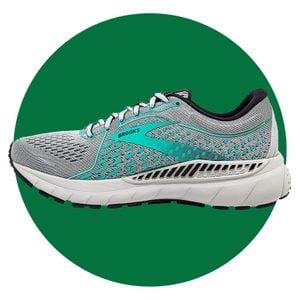
Brooks Adrenaline GTS 21
$111 to $336, depending on size and color
From one of the most popular running shoe lines, the Adrenaline GTS 21 helps decrease overpronation and provide arch support, according to Dr. Fuchs. This makes them a great option for people with flat feet.
“They also have good cushioning and shock absorption from the heel to the forefoot, as well as providing stability by minimizing excess movement,” Dr. Fuchs says. Brooks makes Adrenaline GTS 21 running shoes for both men and women.
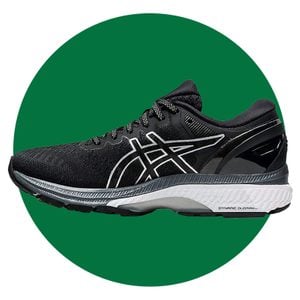
Asics Gel-Kayano 27
$150 to $301, depending on size and color
With impressive cushioning and added support and shock absorption, this classic running shoe from Asics is ideal for people with plantar fasciitis, says Dr. Fuchs. The company makes Gel-Kayano 27 running shoes for both men and women.
“The impact guidance system has a heel with flex grooves that allow for a more flexible sole and softer, smoother foot strike,” she says. “This shoe also provides good support for lower arches or flat feet.”
(Like to golf? Here are the best golf shoes, according to podiatrists.)
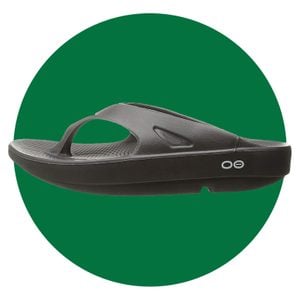
Oofos Post Exercise Active Sport Recovery
$30 to $111, depending on size and color
If you’re looking for a pair of sandals for plantar fasciitis that allow your feet to feel free and airy without sacrificing support, Dr. Fuchs suggests Oofos, which makes this unisex sandal. “These sandals provide a wide strap on top to keep your foot in place and plenty of arch and heel support,” she says. “It feels like you’re walking on clouds.”
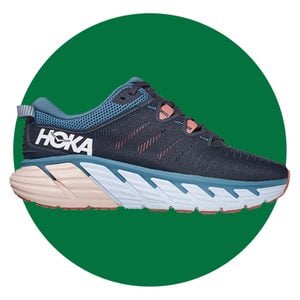
Hoka One One Gaviota 3 Running Shoes
$160
“The outsoles of these sneakers are made from a polyurethane formula that provides great shock absorption,” says Dr. Edwards. “They are extremely comfortable for both walking and running and are great if you are on your feet all day.” Hoka’s Gaviota 3 comes in versions for men and women.
(Here are the best workout shoes for women.)
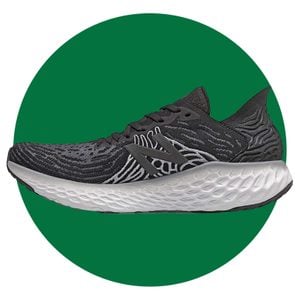
New Balance Fresh Foam 1080 V10
$72 to $265, depending on size and color
The feature that stands out the most when it comes to this pair of running shoes from New Balance is the thick foam midsole, which Dr. Fuchs says provides a good arch and heel support for people with plantar fasciitis. Other noteworthy qualities include its long-lasting durability and breathable upper. The Fresh Foam 1080 V10 sneaker is available in women’s and men’s versions.
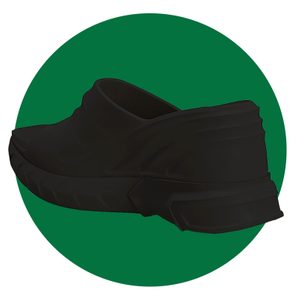
Givenchy Marshmallow Rubber Wedge Slide Sandals
$450
Looking for a slick pair of shoes that you can wear dressed up or down? Dr. Edwards recommends Givenchy’s Marshmallow Rubber Wedge Slide Sandals. “They have a thick platform, and a rocker bottom sole that provides stability and support in all the right ways,” she says. The downside: They’re pricey.
(If you have diabetes, try these best diabetic sandals for women.)
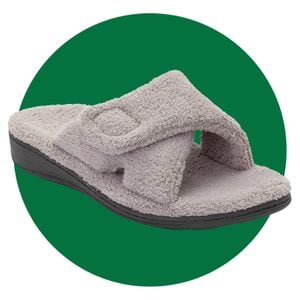
Vionic Women’s Indulge Relax Slipper
$50 to $100, depending on size and color
Even if you’re just lounging around the house, it’s nice to know that your feet are getting the support they need to ease tension and inflammation. For that, Dr. Spielfogel recommends these Vionic slippers, which have good arch support and a removable inlay that can be replaced with a custom orthotic if necessary. The brand also sells men’s slippers.
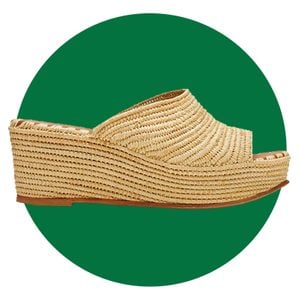
Carrie Forbes Karim Woven Raffia Wedge Slide Sandals
$265
Most people with plantar fasciitis can’t imagine wearing heels that don’t exacerbate the condition, but Dr. Edwards says this pair of wedges from Carrie Forbes is a great choice. “They provide just enough support, thanks to their thick platform and rocker bottom sole,” she says. They work dressed up or down and come in three different colors.
Next, beware of the shoe mistakes hurting your feet.

